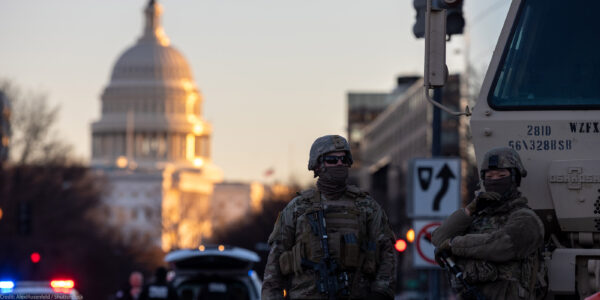The Asymmetry Between Past and Future, and Why it Means Mass Surveillance Won’t Work


Former Senator Joseph Lieberman recently charged that mistakes by U.S. security agencies were responsible for failing to stop the Boston Marathon bombing. I recently wrote about how mass surveillance makes this kind of recrimination inevitable, because once a government agency spies on a person, they become in a sense responsible for any actions that that person takes. To paraphrase Colin Powell, we might sum it up as “You surveil him, you own him.”
I recently came across a good analogy for why it’s deceptively hard for security agencies to detect and stop out-of-nowhere terrorist attacks like the Boston bombing—and why mass surveillance isn’t likely to help. It comes from the book The Drunkard’s Walk: How Randomness Rules Our Lives, by the physicist and writer Leonard Mlodinow, in a discussion of Brownian motion.
Brownian motion, you may recall, is the random jiggling of molecules in a liquid or other substance. A dye molecule floating in a seemingly still glass of water will randomly move about, covering about an inch in three hours, buffeted by random collisions with the smaller water molecules that surround it.
What would it take to actually explain the motion of that molecule? This is where the parallel to anti-terrorism efforts comes in. Mlodinow points out, “In any complex string of events in which each event unfolds with some element of uncertainty, there is a fundamental asymmetry between past and future.” He elaborates:
Now suppose we dig into [a] molecule’s past. Suppose, in fact, we trace the record of all its collisions. We will indeed discover how first this bump from a water molecule and then that one propelled the dye molecule on its zigzag path from here to there. In hindsight, in other words, we can clearly explain why the past of the dye molecule developed as it did. But the water contains many other water molecules that could have been the ones that interacted with the dye molecule. To predict the dye molecule’s path beforehand would have therefore required us to calculate the paths and mutual interactions of all those potentially important water molecules. That would have involved an almost unimaginable number of mathematical calculations, far greater in scope and difficulty than the list of collisions needed to understand the past. In other words, the movement of the dye molecule was virtually impossible to predict before the fact even though it was relatively easy to understand afterward.
Bingo. “Impossible to predict before the fact even though it was relatively easy to understand afterwards.” That pretty much sums up the problem with attempts to prevent terrorist attacks through suspicionless mass surveillance. Just as attempting to predict the path of the dye molecule would have involved “an almost unimaginable number of mathematical calculations,” so too would an attempt to predict a terrorist attack involve an almost unimaginable amount of surveillance and analysis of people’s everyday activities. Each water molecule that could even possibly collide with the dye molecule—and all the other molecules that could affect the paths of each of those molecules—would have to be traced in an endless receding tree of causation. Similarly, think of the endless, unpredictable tree of causation required to predict how, of all the angst and trouble faced by all the human beings among us, one will be somehow moved to engage in terrorist atrocities.
Sen. Lieberman in his written testimony told the House that
an attack like this had been predicted for years, which leads me to conclude that the success of these attacks was the result of errors made within our existing homeland security system—both public and private—and by a failure to do enough at the federal, state, and local levels to counter homegrown terrorism…
We can now see what is wrong with Lieberman’s logic. Even given certain knowledge of the statistical likelihood of an attack, it does not follow that failure to predict and stop it was the result of “errors” on the part of anybody.
I make this point not to defend the FBI or other agencies or argue that they did everything right. Rather, I am trying to combat the naïve view—on display both inside our security agencies and outside them—that we can stop terrorism or other crimes in proportion to how closely we watch everybody all the time. And I do so because there is a significant danger that, because it can seem so easy to see how the elements of a terrorist attack came together after the fact, people will think that it should be that easy to spot those elements in advance. The dots always connect in hindsight.
And to be clear, I’m not arguing that our security agencies shouldn’t chase down real evidence of wrongdoing and other genuine leads—shouldn’t work outward from known evidence using traditional investigative techniques. That works. What the Brownian motion metaphor speaks to is the approach to fighting terrorism that relies on trying to keep tabs on large numbers of people en masse, not based on individualized suspicion. If we pursue that approach, the outcome is predictable: many more incredulous senators, amazed that our security agencies failed to thwart attacks when all the signs seemed so “clear” in advance. And a continued slide towards an unrecognizable surveillance society.
Stay informed
Sign up to be the first to hear about how to take action.
By completing this form, I agree to receive occasional emails per the terms of the ACLU's privacy statement.
By completing this form, I agree to receive occasional emails per the terms of the ACLU's privacy statement.

